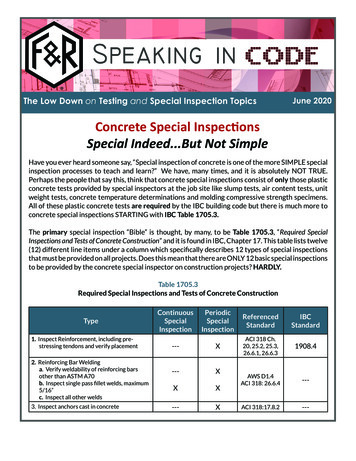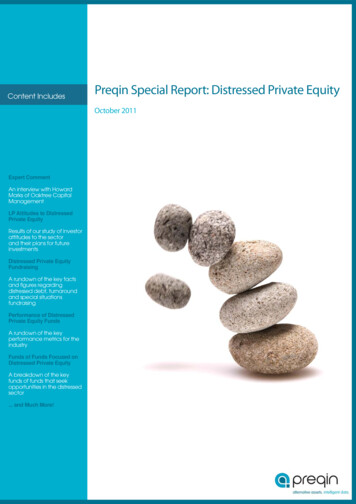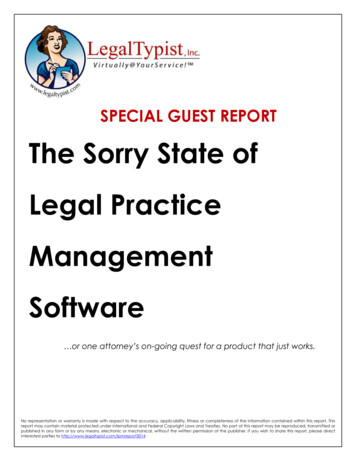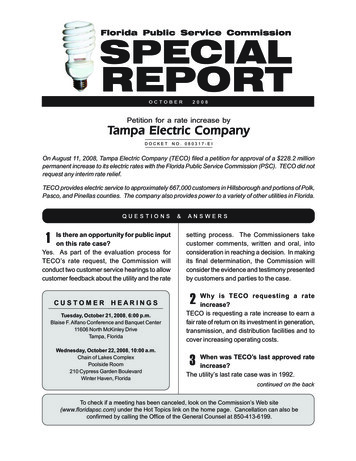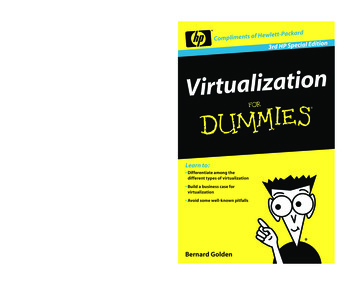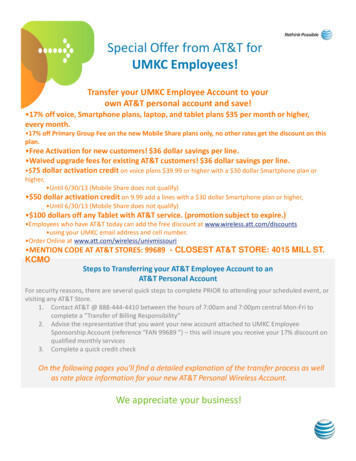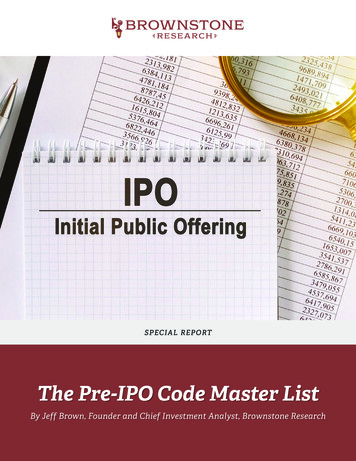
Transcription
SPECIA L REPORTThe Pre-IPO Code Master ListBy Jeff Brown, Founder and Chief Investment Analyst, Brownstone Research
2020SPECIAL REPORTThe Pre-IPO Code Master ListBy Jeff Brown, Founder and Chief Investment Analyst, Brownstone ResearchThe IPO market is on fire After years of staying private, some exciting techcompanies are finally making their move andentering the public markets. And we’re seeingthem skyrocket when they do.Look at Snowflake (SNOW), a bleeding-edgecloud-computing software company. It wentpublic in September as the largest software IPOin history.The company was priced at 120 for its IPO. Butthe stock opened at 245. There was no way fornormal investors to pick up shares anywherebetween 120 and 245 a share. And the stockwent as high as 295 a share, 2.5 times the 120offering price.That’s just one example. There are plenty more This December, DoorDash (DASH) went publicwith a price of 102. But it rocketed 85% on thefirst day of trading, opening at 182 and closingat over 189.Airbnb (ABNB) was much the same. It more thandoubled the 68 price set for its IPO, opening atan astonishing 146. The initial surge on its firstday made Airbnb the 10th best debut in 2020based on the price gain from its IPO.BROWNSTONERESEARCH.COMAnd this is happening with lesser-knowncompanies too An enterprise software company dealing withAI went public on December 9. I was watchingthis one, hoping it would slip through the cracksbecause it isn’t a well-known, consumer-facingcompany like Airbnb or DoorDash. Most peoplehave likely never heard of it.But no such luck.C3.ai (AI) was priced at 42 and opened wellabove 100 per share. By the next day of trading,it had risen to over 130.It’s crazy And it shows just how hungry the market is fornew companies to invest in.A Backlog of IPOsThe IPO market this year has been booming. Wesaw a 30% increase in the number of IPOs from2019 to 2020. And in 2020 alone, IPOs raisedan impressive 76.4 billion And that’s with apandemic going on for a substantial portion ofthe year.2
It’s simply incredible how muchdemand there is for investmentopportunities in these newlypublic companies. And I predictwe will see another record year in2021.In fact, there are thousands ofcompanies lining up to go publicright now. We are staring down amajor IPO backlog.That’s thanks to an abundanceof private capital over the last15 years. High-quality privatecompanies have been ableto consistently raise money and grow theirbusinesses without the scrutiny of being a publiccompany.But that capital is losing its patience. After adecade or more of growth, they are ready to exitpositions and take profits from their successfulinvestments.I’m incredibly excited to see this momentum.It means that exciting companies I’ve beenwatching for years will finally become accessibleto my subscribers But as I described at the beginning, there’s aproblem with these IPOs Left With the Table ScrapsLet me be clear: I don’t recommend anyoneinvest in the companies I mentioned at thebeginning at these levels.At the time of writing, Snowflake has anenterprise value (EV) of 105 billion. That putsits EV/sales ratio at a mind-boggling 260. Thatmeans the current price of SNOW is equivalentto 260 years of revenue (not profits).The other companies have similarlyunsustainable valuations.BROWNSTONERESEARCH.COMOn any negative news or earnings miss, shares arelikely to sell off. Investors are nearly guaranteedto lose money when investing at these levels.There should be an obvious solution. Why don’twe just buy pre-IPO shares? It sounds simple,but it’s not.In traditional IPOs, pre-IPO shares are typicallyreserved for large hedge funds, private equity, orhigh-net-worth investors. They’re typically divviedup in what’s known as a “pre-IPO placement.”But for normal investors? Buying pre-IPO sharesis virtually impossible. Until now Pre-IPO CodesIn my research, I’ve uncovered something I’mcalling a “pre-IPO code” What is a “pre-IPO code”?Very simply, it is a series of letters – no morethan five – that you punch into your brokerageaccount. In exchange, investors are awardedpre-IPO access to exciting early stage companiesbefore they trade on public markets.And before you ask, no. This is not any type ofprivate deal. And no, you don’t need to be anaccredited investor.3
And this opportunity has beenbuilding over recent years.Have a look at the chart at right.It wasn’t until 2014 that preIPO code companies started togain momentum. They raisedover 5 billion in 2014 and 2015collectively, a clear sign of marketinterest. And in the last severalyears, things have really taken off.When we look at pre-IPO codecompanies in the context of theoverall IPO market, it is quite asurprise. In 2019, 23.5% of thetotal 250 IPOs that priced werepre-IPO code companies almostone in four.And it’s easy to understand why there’s so muchinterest in this kind of opportunity.These “pre-IPO code” companies enableinvestors to essentially get shares in companiesbefore their IPOs. And like I said, you don’t haveto be a millionaire accredited investor to invest And here’s the good news There are hundreds of these pre-IPO companiestrading right now.I’ve compiled a master list of all the “pre-IPOcodes” I’ve uncovered during my research. (Seetable on following page.)I want to make sure that investors understandthis new investment opportunity. That’s why I’veprepared my Pre-IPO Code Event.Tune in on Wednesday, January 13, at 8p.m. ET to find out all the details. I’m goingto tell attendees what these pre-IPO codes are,where they come from, and how they can deliverpre-IPO access to some of the most exciting earlystage companies.It’s an event you won’t want to miss. I’ll see youthere.Regards,Jeff BrownFounder & Chief Investment Analyst,Brownstone ResearchYou can see the level of opportunity presenthere BROWNSTONERESEARCH.COM4
XPCYACAACQGNRSNPATo contact us, call toll free Domestic/International: 1-888-512-0726, Mon-Fri: 9am-5pm ET or email memberservices@brownstoneresearch.com. 2020 Brownstone Research, 55 NE 5th Avenue, Delray Beach, FL 33483. All rights reserved. Any reproduction, copying, or redistribution, in whole or in part, is prohibitedwithout written permission from the publisher.Information contained herein is obtained from sources believed to be reliable, but its accuracy cannot be guaranteed. It is not designed to meet your personal situation—weare not financial advisors nor do we give personalized advice. The opinions expressed herein are those of the publisher and are subject to change without notice. It maybecome outdated and there is no obligation to update any such information.Recommendations in Brownstone Research publications should be made only after consulting with your advisor and only after reviewing the prospectus or financialstatements of the company in question. You shouldn’t make any decision based solely on what you read here.Brownstone Research writers and publications do not take compensation in any form for covering those securities or commodities.Brownstone Research expressly forbids its writers from owning or having an interest in any security that they recommend to their readers. Furthermore, all other employeesand agents of Brownstone Research and its affiliate companies must wait 24 hours before following an initial recommendation published on the Internet, or 72 hours after aprinted publication is mailed.BROWNSTONERESEARCH.COM5
reserved for large hedge funds, private equity, or high-net-worth investors. They’re typically divvied up in what’s known as a “pre-IPO placement.” But for normal investors? Buying pre-IPO shares is virtually impossible. Until now Pre-IPO Codes In my research, I’ve uncovered something I’m calling a “pre-IPO code” What is a “pre-IPO code”? Very simply, it is a series .

